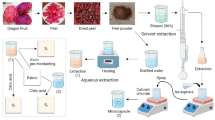Abstract
The purpose of this study was to examine the antibacterial and moisture-management properties of waffle knitted fabric treated with Grona triflora extract. The Grona triflora plant extract was initially prepared using the ethanol solvent through the soxhlet apparatus. Further, the tuck waffle rib gaited fabric was coated in different concentrations over the fabric through a padding mangle and then dried. Subsequently, the plant extract-infused fabric samples were subjected to SEM FTIR analysis to assess the effectiveness of the coating. The treated fabric samples were assessed for antimicrobial activity and moisture management assessment. The highest level of antibacterial activity was observed in all treated fabrics. Among the samples, 30% (W/V) of Grona triflora extract-coated fabric has recorded the highest antimicrobial activity. Similarly, different moisture management indices were analyzed for all the treated samples, and the highest level was found in all the treated samples since their OMMC values were more than 0.6. The conclusion is that cloth treated with Grona triflora extract may find use as medical fabric.





Similar content being viewed by others
Data availability
There is no dataset provided with this submission.
References
Ibrahim NA, Eid BM, Sharaf SM (2019) Functional finishes for cotton-based textiles: current situation and future trends. Text Cloth Environ Concerns Solut 131–190. https://doi.org/10.1002/9781119526599.CH7
Bongomin F, Gago S, Oladele RO, Denning DW (2017) Global and multi-national prevalence of fungal diseases—estimate precision. J Fungi (3):57. https://doi.org/10.3390/JOF3040057
Boominathan S, Karthi V, Balakrishanan S (2020) Optimization of process parameters on color strength and antimicrobial activities of cotton fabric dyed with Rubia cordifolia extract. https://doi.org/10.1080/15440478.2020.1818347
Gonzalez-Pastor R, Carrera-Pacheco SE, Zúñiga-Miranda J et al (2023) Current Landscape of Methods to Evaluate Antimicrobial Activity of Natural Extracts. Mol 28:1068. https://doi.org/10.3390/MOLECULES28031068
Senthil Kumar B, Patchiyappan KM, Senthil Kumar CB (2022) Process optimization of antimicrobial treatment on tencel knit fabrics using chitosan biopolymer. J Test Eval 49:3637–3645. https://doi.org/10.1520/JTE20200382
Boominathan S, Magesh G, Balakrishnan S (2021) Antimicrobial and Mosquito Repellent Finish on Cotton Fabric Using Coleus Aromaticus Leaf Extract. J Nat Fibers 19(12):4707–17. https://doi.org/10.1080/15440478.2020.1870620
B S, K S, G M, (2022) Mechanical and in-vitro studies of biodegradable chitosan/cissus quadrangularis coated flax sutures for anterior cruciate ligaments repair. J Ind Text 51:5756–5773. https://doi.org/10.1177/15280837221082031/ASSET/IMAGES/LARGE/10.1177_15280837221082031-FIG9.JPEG
Gupta D, Laha A (2007) Antimicrobial activity of cotton fabric treated with Quercus infectoria extract. IJFTR 32:88–92
Whangchai K, Shanmugam S, Van Le Q et al (2023) Study of antimicrobial activity of Thespesia populnea-coated nanozirconium on cotton gauze fabrics. Appl Nanosci 13:605–611. https://doi.org/10.1007/S13204-021-01867-8/METRICS
Boominathan S, Karthi V, Balakrishanan S (2020) Optimization of process parameters on color strength and antimicrobial activities of cotton fabric dyed with Rubia cordifolia extract. J Nat Fibers 19:2414–2428. https://doi.org/10.1080/15440478.2020.1818347
Nguyen TCV, Rajeswari VD, Al-Kheraif AA, Brindhadevi K (2023) Study of antimicrobial properties of Piper betel coated nanozirconium on cotton gauze. Appl Nanosci 13:3301–3307. https://doi.org/10.1007/S13204-021-01987-1/METRICS
Dwivedi K, Sharma E, Singh A, Fatima N (2023) Herbal Antimicrobial Finishing of Cotton and Khadi Fabric Using Moringa (Moringa Oleifera) Leaves Extract. Int J Agric Sci 08
Akatwijuka O, Abdelgawad AM, Hassanin AH (2023) Valorization of natural bark cloth fabric from Ficus natalensis for potential antimicrobial applications. Biomass Convers Biorefinery 1–14. https://doi.org/10.1007/S13399-023-04790-W/FIGURES/16
Azab D, Mowafi S, El-Sayed H (2023) Simultaneous dyeing and finishing of wool and natural silk fabrics using Azolla pinnata extract. Emergent Mater 6:1329–1338. https://doi.org/10.1007/S42247-023-00519-7/METRICS
Margret Soundri G, Boominathan et al (2022) Comparative Moisture Management Studies of Single Jersey Knitted Soya Bean Fabrics. J Nat Fibers 19:12462–12472. https://doi.org/10.1080/15440478.2022.2072994
GPalaniappan D Anita Rachel CB Sentilkumar et al 2023 Studies on thermal and moisture properties of novel Eri silk knitted structures Res J Text Appar https://doi.org/10.1108/RJTA-11-2022-0131/FULL/XML
Bhosle V (2013) Anticonvulsant and antioxidant activity of aqueous leaves extract of Desmodium triflorum in mice against pentylenetetrazole and maximal electroshock induced convulsion. Rev Bras Farmacogn 23:692–698. https://doi.org/10.1590/S0102-695X2013005000047
Singh V, Singh R, Singh MP, Katrolia A (2022) Therapeutic Role of Desmodium Species on its Isolated Flavonoids. Curr Mol Med 24:74–84. https://doi.org/10.2174/1566524023666221213111851
Thilagavathi G, Bala K, Kannaian T (2007) Microencapsulation of herbal extracts for microbial resistance in healthcare textiles. IJFTR 32:351–354
Shanmugasundaram OL, Gowda RVM (2011) Development and characterization of bamboo gauze fabric coated with polymer and drug for wound healing. Fibers Polym 12:15–20. https://doi.org/10.1007/S12221-011-0015-6/METRICS
Shobanasree PC, Prakash C, Kumar MR (2023) Moisture management properties of cellulose single jersey fabrics. Indian J Fibre Text Res 48:287–294. https://doi.org/10.56042/IJFTR.V48I3.6054
Author information
Authors and Affiliations
Contributions
A.Saniya: Experimental work, sample preparation, visualization.
R.Divya & M.Sharmila: characterization, characterization, material sourcing, writing support.
B.Senthil kumar: manuscript writing, editing, coordination.
Selvaraj Senthilkumar: characterization.
Corresponding author
Ethics declarations
Ethical approval
Not applicable.
Competing interests
The authors declare no competing interests.
Additional information
Publisher's Note
Springer Nature remains neutral with regard to jurisdictional claims in published maps and institutional affiliations.
Rights and permissions
Springer Nature or its licensor (e.g. a society or other partner) holds exclusive rights to this article under a publishing agreement with the author(s) or other rightsholder(s); author self-archiving of the accepted manuscript version of this article is solely governed by the terms of such publishing agreement and applicable law.
About this article
Cite this article
Saniya, A., Divya, R., Sharmila, M. et al. Investigation of selected functional properties of Grona trifloral biomass treated cotton fabric. Biomass Conv. Bioref. (2024). https://doi.org/10.1007/s13399-024-05426-3
Received:
Revised:
Accepted:
Published:
DOI: https://doi.org/10.1007/s13399-024-05426-3




